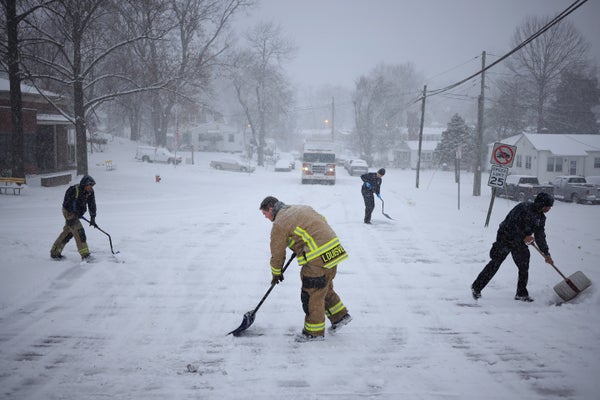
WWW.SCIENTIFICAMERICAN.COM
Dangerously Cold Temperatures Are Way below Normal, but Normal Is Getting Warmer
January 7, 20254 min readFrigid Temperatures Are Way below Normal This Week, but Normal Is Getting WarmerBlasts of Arctic air have brought frigid temperatures that are much colder than normal to parts of the U.S., but that normal background is warmer than in the pastBy Richard B. (Ricky) Rood & The Conversation US Firefighters with Louisville Fire Department Quint 9 shovel snow in front of their station on January 5, 2025 in Louisville, Kentucky. Local forecasts called for heavy snowfall followed by significant accumulation of freezing rain and ice. Luke Sharrett/Getty ImagesThe following essay is reprinted with permission from The Conversation, an online publication covering the latest research.An Arctic blast hitting the central and eastern U.S. in early January 2025 is creating fiercely cold conditions in many places. Parts of North Dakota dipped to more than 20 degrees below zero, and people as far south as Texas woke up on Jan. 6 to temperatures in the teens. A snow and ice storm across the middle of the country added to the winter chill.Forecasters warned that temperatures could be 10 to more than 30 degrees below normal across much of the eastern two-thirds of the country during the first full week of the year.On supporting science journalismIf you're enjoying this article, consider supporting our award-winning journalism by subscribing. By purchasing a subscription you are helping to ensure the future of impactful stories about the discoveries and ideas shaping our world today.But what does normal actually mean?While temperature forecasts are important to help people stay safe, the comparison to normal can be quite misleading. Thats because what qualifies as normal in forecasts has been changing rapidly over the years as the planet warms.Defining normalOne of the most used standards for defining a science-based normalis a 30-year average of temperature and precipitation. Every 10 years, the National Center for Environmental Information updates these normals, most recently in 2021. The current span considered normal is 1991-2020. Five years ago, it was 1981-2010.But temperatures have been rising over the past century, and the trend has accelerated since about 1980. This warming is fueled by the mining and burning of fossil fuels that increase carbon dioxide and methane in the atmosphere. These greenhouse gases trap heat close to the planets surface, leading to increasing temperature.How U.S. temperatures considered normal have changed over the decades. Each 30-year period is compared to the 20th-century average.NOAA NCEIBecause global temperatures are warming, whats considered normal is warming, too.So, when a 2025 cold snap is reported as the difference between the actual temperature and normal, it will appear to be colder and more extreme than if it were compared to an earlier 30-year average.Thirty years is a significant portion of a human life. For people under age 40 or so, the use of the most recent averaging span might fit with what they have experienced.But it doesnt speak to how much the Earth has warmed.How cold snaps today compare to the pastTo see how todays cold snaps or todays warming compare to a time before global warming began to accelerate, NASA scientists use 1951-1980 as a baseline.The reason becomes evident when you compare maps.For example, January 1994 was brutally cold east of the Rocky Mountains. If we compare those 1994 temperatures to todays normal the 1991-2020 period the U.S. looks a lot like maps of early January 2025s temperatures: Large parts of the Midwest and eastern U.S. were more than 7 degrees Fahrenheit (4 degrees Celsius) below normal, and some areas were much colder.How temperatures in January 1994 compare to the 1991-2020 average, the current 30-year period used to define normal.NASA Goddard Institute for Space StudiesBut if we compare January 1994 to the 1951-1980 baseline instead, that cold spot in the eastern U.S. isnt quite as large or extreme.Where the temperatures in some parts of the country in January 1994 approached 14.2 F (7.9 C) colder than normal when compared to the 1991-2020 average, they only approached 12.4 F (6.9 C) colder than the 1951-1980 average.How temperatures in January 1994 compared to the 1951-1980 average.NASA Goddard Institute for Space StudiesAs a measure of a changing climate, updating the average 30-year baseline every decade makes warming appear smaller than it is, and it makes cold snaps seem more extreme.Conditions for heavy lake-effect snowThe U.S. will continue to see cold air outbreaks in winter, but as the Arctic and the rest of the planet warm, the most frigid temperatures of the past will become less common.That warming trend helps set up a remarkable situation in the Great Lakes that were seeing in January 2025: heavy lake-effect snow across a large area.As cold Arctic air encroached from the north in January, it encountered a Great Lakes basin where the water temperature was still above 40 F (4.4 C) in many places. Ice covered less than 2% of the lakes surface on Jan. 4.That cold dry air over warmer open water causes evaporation, providing moisture for lake-effect snow. Parts of New York and Ohio along the lakes saw well over a foot of snow in the span of a few days.The accumulation of heat in the Great Lakes, observed year after year, is leading to fundamental changes in winter weather and the winter economy in the states bordering the lakes.Its also a reminder of the persistent and growing presence of global warming, even in the midst of a cold air outbreak.This article was originally published on The Conversation. Read the original article.
0 Σχόλια
0 Μοιράστηκε
147 Views


